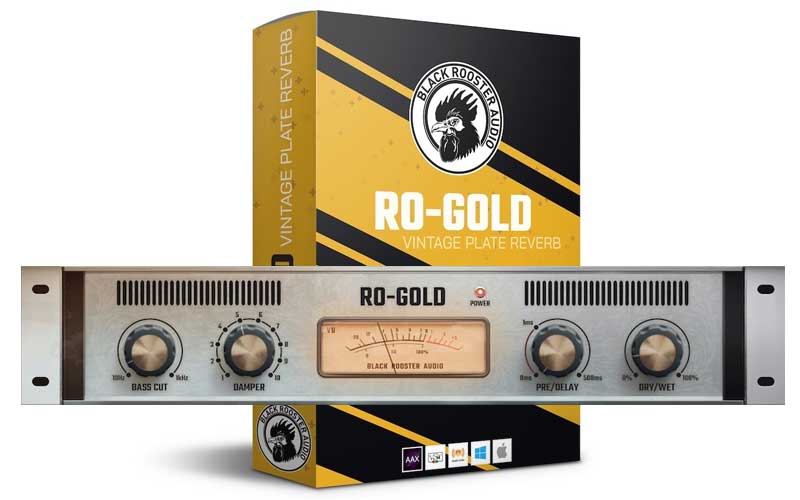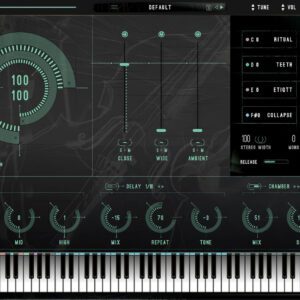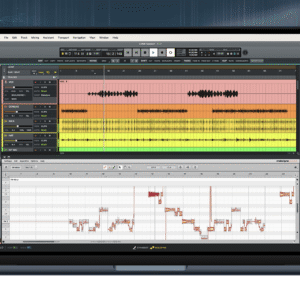
We only recommend products that we use and believe in. When you purchase through links on our site, we may earn an affiliate commission.
The Ro-Gold Plate Reverb Plug-In Is Inspired By The Late-Fifties Vintage EMT 140 Reverberation Unit
Black Rooster Audio “BRA” is proud to release its aptly-named RO-GOLD vintage plate reverb plug-in — authentically modeled after a hardware classic upgraded with a 24k gold plate for the most luxurious vintage reverberation experience, extensively compatible with all major DAWs (Digital Audio Workstations) — available for free as of August 30…
As an effect, reverb remains the quintessential element of modern-day music and sound design production, adding instant depth and atmosphere to any mix. It is perfectly possible to mimic (almost) any space in today’s age of on-tap reverb — all the more so in an ever-widening world of contemporarily convenient effect plug-ins, yet recording with the desired type and amount of reverberation has not always been so straightforward. Step back in time, then, to a different world, when a plate reverb’s original purpose was to emulate reverberant rooms — somewhat crudely, some might say. Saying that, though, when heard through today’s ears, some such solutions have historically become somewhat legendary themselves. The difference between a classic piece of hardware such as the late-Fifties-vintage (mono) EMT 140 Reverberation Unit — a somewhat bulky beast measuring around eight feet by four feet and weighing in at just over quarter of a ton as the world’s first plate reverb (using an electromechanical transducer, similar to that typically found in a loudspeaker, to create vibrations through the plate made from thin steel suspended between tubular steel frames, while pickups, like those found on an electric guitar, would capture those vibrations as they moved across the plate and output them to the console) — or its early-Sixties-vintage stereo successor and most modern, purely impulse response-based plug-ins is immediately apparent to any discerning ear!
Enter Black Rooster Audio’s aptly-named RO-GOLD vintage plate reverb plug-in into that modern-day music and sound design production fray; it is inspired by the aforesaid EMT 140 Reverberation Unit and other classic plate reverbs for maximum modelled authenticity, while still remaining an original Black Rooster Audio plug-in at its creative core. Indeed, its plate simulation approach allowed the German company concerned — best known for its beautifully-designed vintage gear emulation plug-ins — to authentically capture the analogue unit’s sound and feel as closely as possible, while still including a few unexpected twists as a beautifully-designed, easy-to-use plug-in package.
Put it this way: while engineers have experimented with foil and metal plates to reproduce expensive reverb rooms since the Fifties, installing and controlling a real metal plate reverb has never been easily attainable, nor has it been readily available to every producer or small studio — all the more so when it comes to real gold plates. It is hardly surprising, therefore, that this type of hardware remained exclusive to a select few elite studios — such as California’s classic Capitol Studios and Gold Star Studios, as well as London’s legendary EMI Recording Studios (subsequently renamed Abbey Road Studios) — for a long time. That said, plate reverberation remains audible in many hit songs recorded throughout the Fifties and Sixties, where engineers extensively used this technique.
Fast-forward through to today, though, and not only does RO-GOLD authentically take the sound of those sought-after hardware classics to all major DAWs, but it also captures the true tone of a solid gold plate, which would cost a sizeable seven-figure sum to recreate in the contemporary real world. While this 24k gem allows anyone to set up their own retro room sound that is both warm and mellow, it has never been easier to achieve an authentic vintage reverb sound, thanks to the following few, simple-to-use parameters: complete control over the reverb decay time comes courtesy of a physically modelled version of a classic damper control, so users can choose between 10 DAMPER positions; purposefully placed after the plate reverb emulation to enable users to modulate the reverb tail with DAW automation, the classic PRE/DELAY (0ms to 500ms) control determines the amount of delay between the dry and wet signals; following the classic approach of send effects that run in parallel with the mix channel, the DRY/WET (0% to 100%) control keeps the effect in-chain within the plug-in, without having to set up additional send/return loops; and the BASS CUT control applies a high-pass filter that cuts the bass at any desired frequency between 10Hz and 1kHz. All are assisted by a lovely-looking VU meter that provides visual feedback for the reverb settings and signals.
EMT 140 Plate Reverb December 11, 2012 by Jack Menhorn Guest Contribution by Elizabeth McClanahan, Assistant Mixer at Heard City The majority of today’s common reverb plugins contain plate reverb settings, the designs of which are primarily based upon the popular Elektromesstechnik (EMT) 140 model plate. Upon its introduction in 1957, the EMT 140 Reverberation Unit quickly garnered popularity, providing a smoother substitute to spring reverb systems, as well as proving more space conscious and malleable than reverb chambers. While the EMT 140 presented a more practical alternative to other reverbs of its era, the advent of digital units created similar convenience advantages in an even more accessible package. The 1957 production of the EMT plate marked a significant change in recording history, simplifying the process of affecting recorded sound while providing the engineer with a more versatile and customizable interface. Much like today’s convolution reverbs simultaneously provide convenience and complex control to reverb manipulation, the original EMT 140 plate established a consequential alternative to both spring reverbs and chambers. Despite its roughly 600 pound weight, the EMT 140 plate provided a smaller solution to large echo rooms. Additionally, a remote controlled damping pad system allowed the engineer to adjust the reverb time, offering substantially more control than possible with a traditional chamber. The sheet metal plate is suspended from its frame by springs, a transducer mounted at the center of the plate drives movement, and returns consist of pickups mounted on the plate. While the 140 was originally available only in mono, EMT released a stereo model in 1961. Though more convenient than its predecessors, the EMT 140 plate still required substantial storage space, and EMT’s own foray into digital reverb, most successfully with the EMT 250 in 1976, illustrated growing demand for easily controlled and versatile multi-effects units. Such early digital systems, including the ubiquitous Lexicon 480L, contained plate programs loosely based upon the original EMT 140. However, the sonic qualities of the 140 plate have been more accurately reproduced with modern modeling and convolution reverb plugins. Like with any emulator plugins, the selection of gear from which to gather measurements greatly affects the outcome, and ultimately success, of any digital recreation. Those familiar with the EMT 140 plates will undoubtedly form opinions based on the individual plates with which they are familiar. Like any other classic gear, including the popular 1176 and LA2A, age, maintenance, and modifications factor into the sonic character of an individual piece of equipment.
DSP (Digital Signal Processing) operations are pipelined using the latest Apple Silicon and SSE2 (Streaming SIMD Extensions 2) instruction sets to ensure that the RO-GOLD vintage plate reverb plug-in benefits from a high-performance operation — despite its very complex computations. Clearly, the GUI (Graphical User Interface) supports high-pixel density on both macOS and Windows systems, providing users of whatever persuasion with the most enjoyable experience, visually, on high DPI (Dots Per Inch) displays.
But best of all, RO-GOLD is free for everyone, so it is really worth its weight in gold! Achieving an authentic vintage reverberation is simply a case of signing up for — or into — a Black Rooster Audio account (here: https://blackroosteraudio.com/en/landing/ro-gold) and activating the plug-in via e-mail. Entering Abbey Road Studios in the UK or Capitol Studios in the USA is entirely optional, but the most luxurious and exclusive vintage room effect meeting modern-day features for the highest-quality sound and optimal usability with RO-GOLD is a given! (Gold Star Studios, sadly, is no longer with us, having closed its doors back in 1984, a fire destroying the building several months after the studios themselves were vacated.)
RO-GOLD is available for free as a 64-bit AAX-, AU-, and VST-compatible plug-in for macOS (10.9 or later) and AAX- and VST-compatible plug-in for Windows (7 or later) by signing up for — or into — a Black Rooster Audio account (and activating it via e-mail) from here: https://blackroosteraudio.com/en/landing/ro-gold (More in-depth info — including some superb-sounding audio and video demos — is also available there.)
Where to buy:
Anyone interested in exploring other plate materials and sizes is invited to check out Black Rooster Audio’s best-selling RO-140 vintage plate reverb plug-in, available to purchase — as a 64-bit AAX-, AU-, and VST-compatible plug-in for macOS (10.9 or later) and AAX- and VST-compatible plug-in for Windows (7 or later) — for $29.00 USD via its dedicated webpage, which also includes in-depth information (including some superb-sounding audio demos), here: https://blackroosteraudio.com/en/products/ro-140



